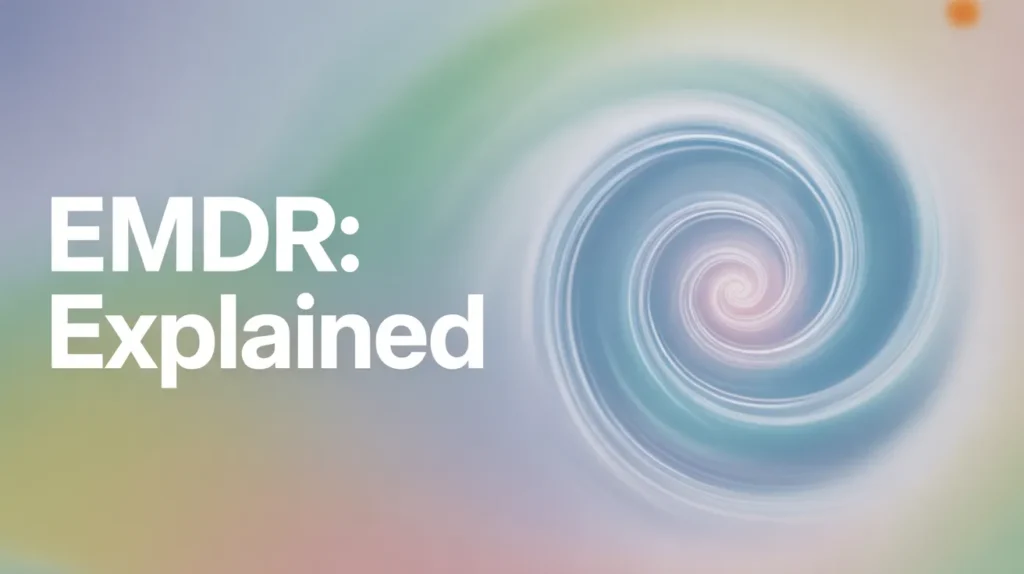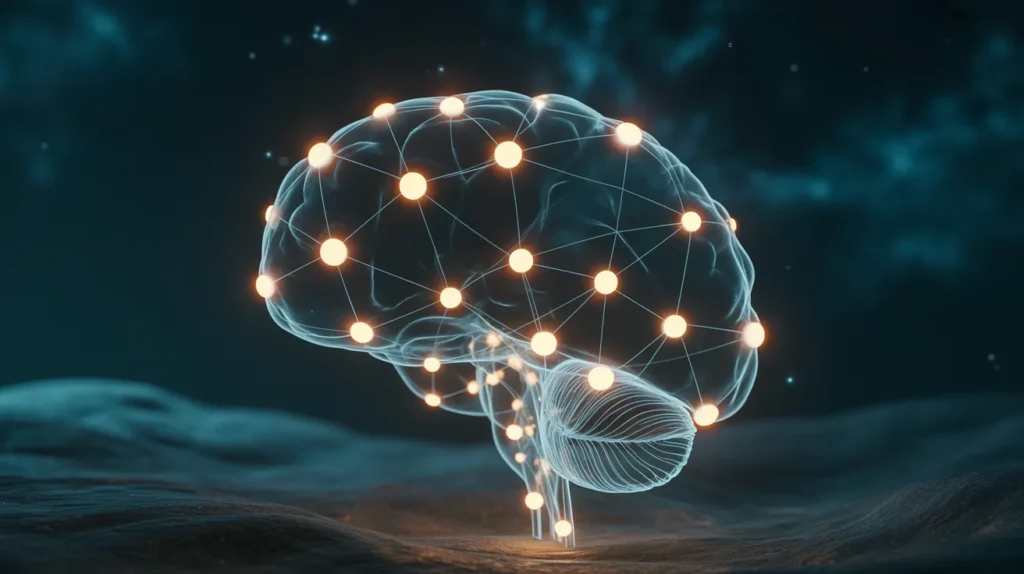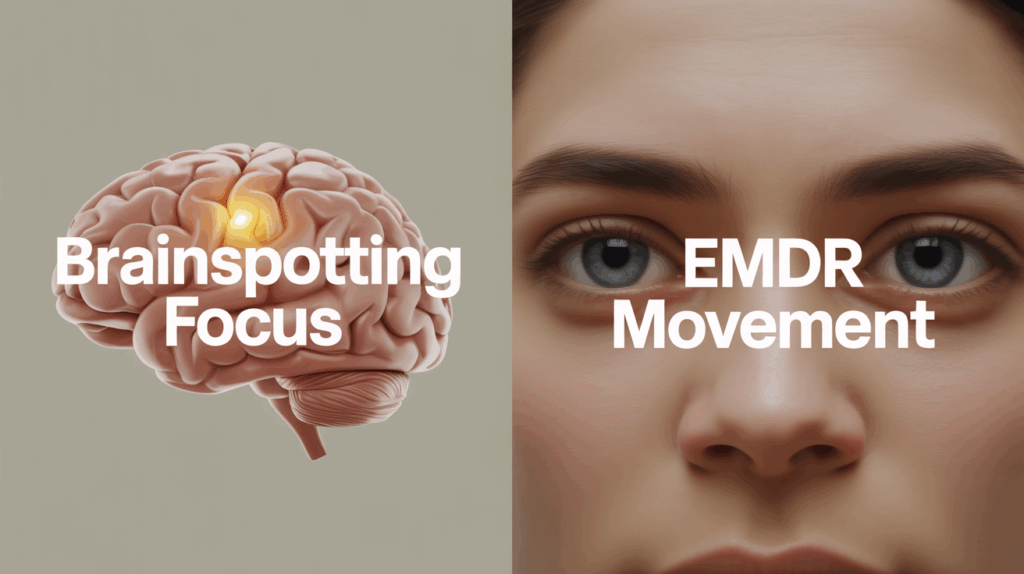Brainspotting vs EMDR
Introduction
When comparing Brainspotting vs EMDR, people often want to know which therapy works better for trauma, stress, and mental health treatment. Both therapies focus on the connection between the brain, eye movement, and memory recall. Each method helps individuals reduce distress, heal emotional wounds, and restore balance in their mental health.
What is EMDR?
EMDR stands for Eye Movement Desensitization and Reprocessing. This therapy helps people process painful memories by pairing eye movement with desensitization techniques. EMDR was first recognized by the American Psychological Association as an effective therapy for trauma, anxiety disorder, and post-traumatic stress disorder (PTSD).

How EMDR Works
During EMDR, the therapist asks the patient to focus on a troubling memory while moving their eyes side to side. This eye movement activates the brain’s limbic system and amygdala, which store memory and emotion. The process supports cognitive restructuring, emotional regulation, and the release of fear.
Conditions EMDR Treats
EMDR is widely used for trauma, phobia, panic disorder, social anxiety disorder, and major depressive disorder. It also benefits people facing grief, postpartum depression, and panic attacks. Many patients in rehab for addiction or substance abuse also receive EMDR as part of a dual diagnosis treatment plan.
What is Brainspotting?
Brainspotting is a therapy that uses the eye’s visual field to locate where trauma is stored in the brain. A therapist helps the patient find a “brainspot,” an eye position linked to unresolved distress. This technique helps the nervous system and limbic system access feelings that may not be fully processed through talk therapy.
How Brainspotting Works
During Brainspotting, the therapist observes subtle cues like eye movement, body tension, or fatigue. Once the brainspot is found, the client holds their attention on that spot while focusing on the memory or feeling. This process builds awareness, reduces stress, and allows emotional healing to occur.
Conditions Brainspotting Treats
Brainspotting helps with anxiety disorder, emotional dysregulation, panic, and phobia. It is often used for patients with trauma, bipolar disorder, attention deficit hyperactivity disorder, and dissociation. Brainspotting can also support people working through grief, pain, social anxiety, and fatigue.
Brainspotting vs EMDR: Key Similarities
Both Brainspotting and EMDR are therapies designed to help patients process trauma and reduce distress. Each focuses on eye movement, memory recall, and the brain’s emotional centers. These therapies improve coping, stress management, and awareness while reducing fear and panic.
Healing Through the Brain
In both therapies, the brain is central to healing. The amygdala, limbic system, and cognition play major roles in how memory and emotion are processed. Each therapy can reduce the intensity of distress linked to past experiences while improving mental health and quality of life.

Evidence and Research
Research shows EMDR has more established evidence, with many clinical trials proving its effectiveness. Brainspotting is newer but growing in psychology and mental health research. Both therapies are practiced by licensed therapists, health professionals, and mental health professionals trained in trauma work.
Brainspotting vs EMDR: Key Differences
While EMDR uses structured sets of eye movement and desensitization, Brainspotting focuses on the visual field and patient preference. EMDR follows eight phases, while Brainspotting is more flexible and guided by the therapeutic relationship.
Patient Experience
Some patients prefer EMDR for its structured nature and strong evidence base. Others prefer Brainspotting because it feels less rigid and allows more creativity, meditation, or yoga alongside therapy. Both can reduce stress, fear, and emotional dysregulation while supporting recovery.
Therapeutic Relationship
Brainspotting places a strong emphasis on the therapeutic relationship and awareness. The therapist helps the client hold attention on their chosen brainspot while supporting healing. EMDR relies more on protocol, though the therapist remains a guide throughout.
EMDR at Revival Mental Health
At Revival Mental Health in Orange County, EMDR is offered as part of our mental health treatment programs. Our therapists use this evidence-based therapy to help patients process trauma, reduce distress, and improve memory recall. EMDR is especially effective for people experiencing anxiety disorder, panic attacks, or major depressive disorder.
We also provide EMDR for patients in dual diagnosis programs who face both substance abuse and mental health challenges. By targeting the nervous system and limbic system, EMDR helps reduce fear and emotional dysregulation. This therapy supports long-term healing while improving coping skills, sleep, and overall mental health.
Choosing Between Brainspotting and EMDR
Choosing Brainspotting vs EMDR often comes down to patient preference and mental health needs. People dealing with severe trauma or PTSD may benefit from EMDR due to its strong evidence base. Those seeking a more open, creative therapy may choose Brainspotting.
Integration with Other Therapies
Both therapies can be integrated with dialectical behavior therapy, couples therapy, art therapy, or counseling. Rehab programs for addiction or substance abuse often include EMDR or Brainspotting alongside coping strategies, meditation, or relaxation techniques.
Professional Support
A mental health professional, therapist, or psychiatrist can help determine which therapy is best. At Revival Mental Health, our health professionals provide EMDR and other therapies as part of comprehensive mental health treatment.
The Role of Memory and Emotion
Both therapies highlight how memory and emotion shape behavior and mental health. Traumatic memory can lead to anxiety disorder, depression, or panic disorder. By reprocessing memory through eye movement or brainspotting, patients gain insight and reduce distress.
Cognition and Awareness
EMDR encourages cognitive restructuring to reshape negative thoughts. Brainspotting enhances awareness by connecting eye position with feeling and experience. Both approaches promote healing, attention control, and stress management.
Benefits of Brainspotting vs EMDR
The benefits of both therapies include reduced anxiety, better coping, and improved emotional regulation. Patients experience less fear, panic, and dissociation. Both therapies help with grief, social anxiety, postpartum depression, and fatigue.
Long-Term Mental Health
Brainspotting and EMDR contribute to long-term healing by calming the nervous system and balancing the brain’s response to stress. They improve sleep, reduce pain, and support emotional regulation. Over time, patients report improved mental health and healthier behavior.
Brainspotting vs EMDR in Rehab and Dual Diagnosis
Addiction treatment and dual diagnosis programs often use these therapies to address both substance abuse and underlying mental health conditions. A therapist may use EMDR to desensitize triggers related to drug or alcohol use. Brainspotting may help patients uncover hidden trauma connected to relapse.
Peer Support and Coping
Peer support, social work, and counseling help patients practice new coping strategies. Combining these therapies with relaxation techniques, yoga, or meditation supports healing and reduces relapse risk. Many patients find creativity and art therapy valuable in their recovery journey.

Alternatives to EMDR and Brainspotting
For patients who may not be a fit for EMDR or Brainspotting, several alternatives are available. Dialectical behavior therapy, art therapy, couples therapy, and counseling are all effective options for managing stress, grief, and emotional pain. Practices like meditation, yoga, and relaxation techniques can also calm the nervous system and improve sleep.
Other therapies such as cognitive restructuring, stress management training, and psychiatry-led interventions are often included in mental health treatment. At Revival Mental Health, our health professionals provide a wide range of therapies that address addiction, phobia, social anxiety disorder, and emotional dysregulation. These approaches give patients flexibility, insight, and coping strategies for lasting recovery.
Stress Management with Brainspotting vs EMDR
Stress plays a major role in mental health disorders such as major depressive disorder, anxiety disorder, and bipolar disorder. Both therapies promote stress management by helping patients process painful memory and release distress.
Relaxation and Healing
Patients often pair these therapies with relaxation techniques, meditation, or yoga. These practices calm the nervous system, reduce fatigue, and support sleep. Over time, patients feel more control over emotion and behavior.
Conclusion
When comparing Brainspotting vs EMDR, the choice depends on personal goals, preference, and mental health needs. EMDR has strong evidence, structured desensitization, and recognition from the American Psychological Association. Brainspotting provides flexibility, deeper awareness, and a focus on the therapeutic relationship.
At Revival Mental Health, our therapists and health professionals integrate EMDR and other therapies into mental health treatment. Whether you face trauma, addiction, substance abuse, grief, or emotional dysregulation, our team provides insight, healing, and evidence-based care.
FAQs
1. Can Brainspotting and EMDR be combined in therapy? Yes, some therapists integrate both methods. This approach can enhance memory processing and emotion regulation while supporting broader mental health goals.
2. How long does it take to see results from Brainspotting or EMDR? Results vary, but some people feel relief after a few sessions. Others may need several months of therapy depending on memory recall and trauma severity.
3. Is Brainspotting or EMDR safe for children and teens? Both therapies can be used with younger clients. Therapists adjust techniques to match age, attention level, and developmental needs for safety and effectiveness.
4. Does insurance cover Brainspotting or EMDR? Many insurance plans cover EMDR since it has strong research support. Brainspotting may also be covered, but coverage depends on the policy and provider.





